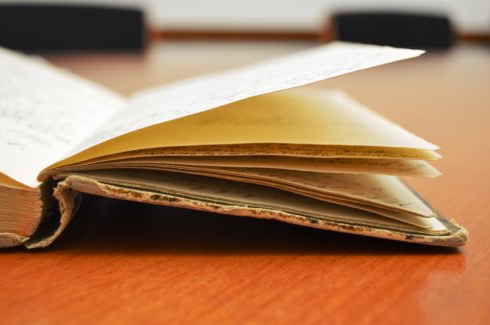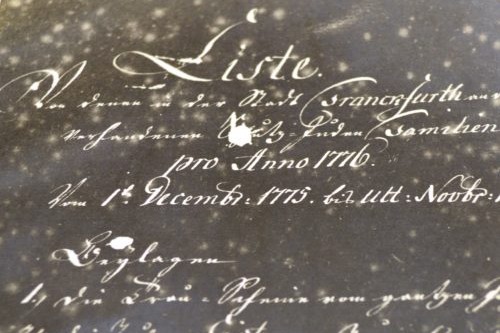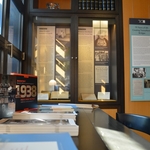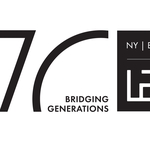Research, Exploitation, and Survival: The Story of Jacob Jacobson, a Jewish Archivist in Nazi Germany


- Author
- Michael Simonson
- Date
- Fri, Mar 3, 2017
One of the largest and most-used collections in the LBI archives is named for a little known historian and archivist who, like Leo Baeck, survived Theresienstadt. The Jacob Jacobson Collection spans 16 feet of archival boxes plus oversized materials, encompassing birth, death, marriage, and circumcision registers dating back as far as 1671. How could this enormous body of materials survive the Nazi period? When archivist Michael Simonson began reconstructing its provenance, he encountered a complex drama that hinged on the ethical dilemma of a scholar trapped between collaboration and survival.
Jacob Jacobson was born in Schrimm, Germany (now Śrem, Poland) in 1888. After studying history and serving in WWI, he accepted a position as head archivist at the Gesamtarchiv der Deutschen Juden (GDJ—Central Archives of the German Jews), founded 1905 in Berlin as a central repository for communal Jewish records from across Germany. The financial crises of the Weimar period and internecine conflicts over the central archive’s claims to regional records weakened the position of the GDJ and left Jacobson as its only employee, serving a trickle of researchers through the 1920s.
When the National Socialist government began restricting Jews from ever expanding realms of public life beginning in 1933, a certificate proving “Aryan” ancestry became required currency in dealing with various bureaucracies. Determining racial status was not straightforward. Jewish conversion, secularization, illegitimacy, and disputed parentage resulted in tens of thousands of cases that the authorities sought to interpret in accordance with their ideology of race.
The government agency created to certify proof of ancestry, the Reichsstelle für Sippenforschung (RFS—Reich Agency for Genealogical Research) took a strong interest in the documents in the GDJ, and Jacob Jacobson and his small staff were suddenly besieged by visitors. There were Jewish and part-Jewish researchers, non-Jews trying to clarify rumors about their own status, and visits from RFS officials.
The National Socialist project of documenting racial ancestry dovetailed with Jacobson’s own professional interest in Jewish genealogy, and in some ways the archive benefited from the new attention. With funding and authorization from the RFS, Jacobson was able to travel across Germany collecting records from Jewish communities large and small, thus fulfilling the longstanding stated mission of the GDJ.
Jacobson was not arrested on November 9, 1938 like so many other Jewish men, but he and his family recognized the threat and applied for emigration to England. Visas were granted for both his wife and their son, but Jacobson’s own visa was denied. Without Jacobson’s expertise at the GDJ, the RFS feared, many of the thousands of cases of Jewish ancestry would never be solved.
In his memoirs, Jacobson never discusses his feelings about the ambitions of the RFS. As he wrote after the war, “the curious relationship between the RFS and me was conducted in an absolutely correct fashion. However things were going, the gentlemen from the RFS were helpful to me, and they had the same attitude to all the employees of the Archive.”
In 1938 the RFS moved into the GDJ offices next to the Neue Synagogue on Oranienburger Straße. RFS officials now worked on the same floor as the Jewish staff , which had also grown thanks to support from the RFS. The partnership may have been intimate, but it was unequal. In September of 1941, it was ruled that all Jews must wear a yellow star emblazoned with the word Jude (Jew). From then on, Jacobson and the Jewish staff had to use their own entrance and exit to the archives, separate from the so-called “Aryan” doors.
In October 1941, the first mass deportations of Jews from Berlin to the ghettos and death camps in Eastern Europe began. Within 18 months, there were very few Jews left in Berlin. Jacobson had the horrible responsibility of verifying that all those on the deportation lists were Jewish. At the same time he surely knew that failure to fully cooperate might lead to incarceration in Buchenwald or Dachau. In one episode described by Jacobson in his memoirs, a man appeared with a family document written in Hebrew letters and asked Jacobson to read it. When Jacobson did so accurately, the visitor revealed that he worked for the RFS. It had been a test.
In a more chilling instance, when a friend of Jacobson was arrested in September 1942, Jacobson managed to strike him from the deportation list. His friend was saved, but the SS punished Jacobson by ordering him to diminish his archival staff by two-thirds. Those he had to dismiss were deported.
When the National Socialists decided, in a final push, to declare Berlin judenrein (cleansed from Jews) in May 1943, Jacobson was put in the group destined for the Theresienstadt Ghetto in Bohemia. There, he was designated among the so-called Prominente: Jews who were well-known and thus might be asked about by the outside world. Though he was hardly a household name, the RFS still needed Jacobson. Numerous registers from the 17th, 18th, and 19th centuries had yet to be indexed.
By now, allied air raids over Berlin and other German cities were taking place with alarming consistency. Archives across Germany, including the GDJ, were being packed-up for safe storage in old castles, caves, and mines. Unsure of the future of the material, Jacobson brought the most important items with him. In one of the few passages expressing genuine anger in his memoir, Jacobson describes the cluelessness of Czech police who cut open some of his suitcases to inspect his belongings. Nevertheless, the archival material had all been stamped with the seal of the RFS, ensuring its safe passage to Theresienstadt.
In Theresienstadt, Jacobson lived through the months when the majority of the Ghetto, including a large number of the Prominente, were sent in massive transports to Auschwitz. When the Ghetto was liberated in April 1945, Jacob Jacobson, now 56 years old, was among the approximately 18,000 survivors. He still had the material he had brought from the GDJ.
Jacobson brought the files with him that August when he left for England to reunite with his wife and son. In 1972, four years after Jacobson’s death, the material was finally given a new institutional home at the LBI. Other large portions of the GDJ archive also survived the war, and today the bulk of it can be found at the Central Archives for the History of the Jewish People in Jerusalem, with a smaller amount at Centrum Judaicum in Berlin.
Today, the Jacob Jacobson collection is not only a rich resource for genealogists and historians, comprising some of the oldest documents once housed in the GDJ, but it is also a testament to the kinds of impossible moral choices that the National Socialist regime forced on its victims.
Literature:
Hertz, Deborah Sadie, How Jews Became Germans: The History of Conversion and Assimilation in Berlin. Yale University Press, 2007. LBI Library, Call No. DS 135 G4 B4 H478
Jacobson, Jacob, Bruchstücke 1939–1945. LBI Archives, Call No. ME 329.
Jacobson, Jacob, Terezin, the Daily Life: 1943-1945. LBI Archives, Call No. DM 83.




